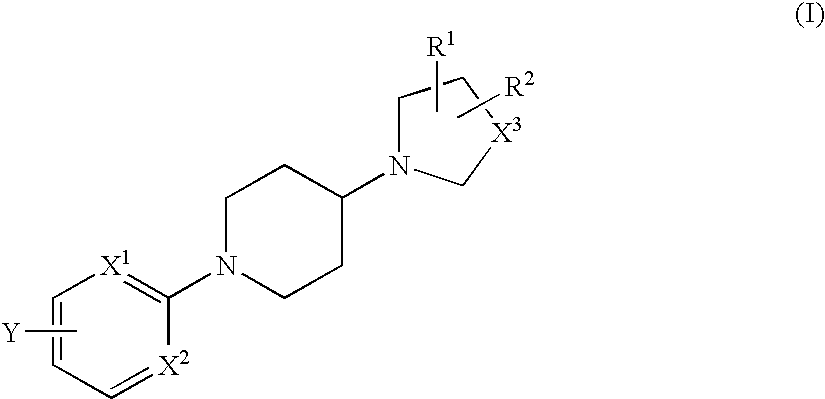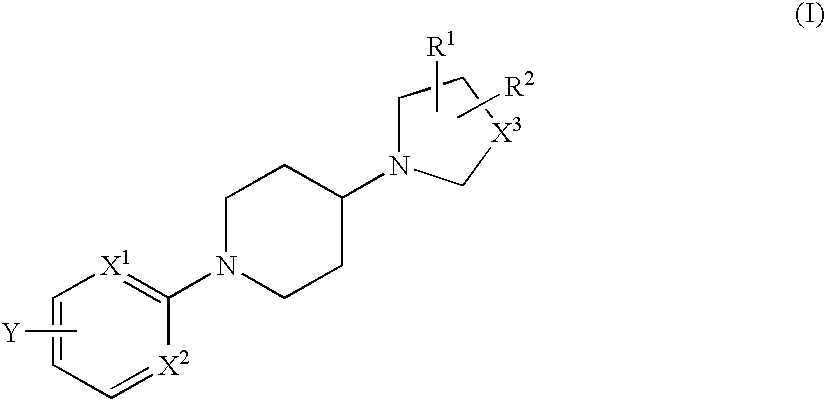Piperidine derivative
- Summary
- Abstract
- Description
- Claims
- Application Information
AI Technical Summary
Benefits of technology
Problems solved by technology
Method used
Image
Examples
fourth embodiment
The fourth embodiment is as follows: The nitrogen-containing heterocyclic group in the third embodiment is condensed with a phenyl group or a pyridyl group to form a bicyclic group. The bicyclic group may include the same as those mentioned hereinabove for the above-mentioned heterocyclic group.
When Y in formula (II) indicates any of the above-mentioned for 4 embodiments, then the aromatic ring in formula (I) to which Y bonds is preferably a phenyl group where X1 and X2 are both CH; or a pyridyl group where any of them is a nitrogen atom.
Case (2):
Y in formula (II) is preferably an aryl group or a 5-membered or 6-membered heteroaryl group, which is unsubstituted or has, in the ring thereof, 1 or 2 substituents selected from a group consisting of a lower alkyl group, a lower alkoxy group, a hydroxyl group and a halogen atom, and may have, in the ring thereof, from 1 to 3 hetero atoms selected from a group consisting of a nitrogen atom, a sulfur atom and an oxygen atom. The aryl group ...
example 1
[Production of Piperidine Derivatives]
Compound 1
N-methyl-N-(1-methylpiperidin-4-yl)-4-[4-(piperidin-1-yl)piperidin-1-yl]benzamide
At room temperature, 1-methyl(4-methylamino)piperidine (0.056 ml, 0.38 mmols), O-(7-azabenzotriazol-1-yl-N,N,N′,N′-tetramethyluronium hexafluorophosphate (121 mg, 0.32 mmols) and diisopropylethylamine (0.17 ml, 0.96 mmols) were added to a dimethylformamide solution (1.0 ml) of 4-[(4-piperidin-1-yl)piperidin-1-yl]benzoic acid hydrochloride (103 mg, 0.32 mmols) obtained in Reference Example 1, and stirred in a nitrogen atmosphere at room temperature for 14 hours. The reaction solution was extracted with ethyl acetate, the organic layer was washed with water, saturated sodium bicarbonate solution and saturated saline solution in the order, dried with anhydrous magnesium sulfate, and then concentrated. The residue was purified through preparative thin-layer chromatography (chloroform / methanol / aqueous ammonia=10 / 1 / 0.1) to obtain the entitled compound (56 mg, 44...
formulation example 1
10 parts of the compound of Example 1, 15 parts of heavy magnesium oxide and 75 parts of lactose were uniformly mixed to prepare a powdery or granular preparation having a particle size of at most 350 μm. The preparation is encapsulated to give capsules.
PUM
| Property | Measurement | Unit |
|---|---|---|
| pressure | aaaaa | aaaaa |
| blood pressure | aaaaa | aaaaa |
| deficit hyperactivity disorder | aaaaa | aaaaa |
Abstract
Description
Claims
Application Information
 Login to View More
Login to View More - R&D
- Intellectual Property
- Life Sciences
- Materials
- Tech Scout
- Unparalleled Data Quality
- Higher Quality Content
- 60% Fewer Hallucinations
Browse by: Latest US Patents, China's latest patents, Technical Efficacy Thesaurus, Application Domain, Technology Topic, Popular Technical Reports.
© 2025 PatSnap. All rights reserved.Legal|Privacy policy|Modern Slavery Act Transparency Statement|Sitemap|About US| Contact US: help@patsnap.com



